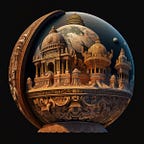Indian painting has a long and rich history, characterized by various styles and techniques that have evolved over millennia. It serves as an important cultural document, capturing the beliefs, traditions, and daily life of diverse communities across the Indian subcontinent.
Major Indian Painting Styles:
All these painting styles were created using Midjourney /imagine {painting style} -v5
Miniature Painting
- Characteristics: Attention to fine details, vivid colors, and often involves intricate brushwork.
- Historical Context: Gained prominence during the Mughal era but has Persian influences.
- Subcategories: Mughal, Rajput, and Deccan miniatures.
Madhubani Painting
- Characteristics: Geometric patterns, bright colors, and natural themes.
- Historical Context: Traditionally done by women on mud walls of their homes.
- Subcategories: Bharni, Kachni, Tantrik, Godna, and Kohbar.
Pichwai Paintings
- Characteristics: Detailed and vivid, often depicting Lord Krishna.
- Historical Context: Associated with the Nathdwara school and the town of the same name in Rajasthan.
- Subcategories: None, but variations exist based on the story of Krishna being depicted.
Kalamkari
- Characteristics: Block-printing or hand-painting on cloth, often using vegetable dyes.
- Historical Context: It has Islamic as well as Hindu influences and was often used for storytelling.
- Subcategories: Srikalahasti style and Machilipatnam style.
Tanjore Painting
- Characteristics: Embellished with gold foils and semi-precious stones.
- Historical Context: Originated in the Maratha court of Thanjavur.
- Subcategories: Mainly traditional, but modern innovations are emerging.
Warli Painting
- Characteristics: Monosyllabic, employing basic shapes like circles and triangles.
- Historical Context: An ancient art form; the Warli tribe believes it brings them closer to nature.
- Subcategories: None, but the themes vary from daily life to festivals.
Rajput Painting
- Characteristics: Lush natural landscapes, detailed costumes, and an emphasis on depicting events from epics.
- Historical Context: Evolved as a response to Mughal painting, incorporating local styles.
- Subcategories: Mewar, Bundi, Kishangarh, and more.
Gond Painting
- Characteristics: Vibrant and filled with patterns and details.
- Historical Context: Derived from the beliefs and folklore of the Gond tribal community.
- Subcategories: Depending on the artist, variations occur in color schemes and motifs.
Kalighat Painting
- Characteristics: Broad brush strokes, bold colors, and simplified forms.
- Historical Context: Developed as a quicker, more economical form of traditional art to cater to the growing urban population.
- Subcategories: None.
Thangka Paintings
- Characteristics: Intricate details often involving religious texts and iconography.
- Historical Context: Developed under Tibetan Buddhist influence.
- Subcategories: Menri and Khyenri styles.
Kerala Murals
- Characteristics: Wall paintings usually in temples, bright color schemes.
- Historical Context: Influences from ancient Indian art forms and traditional craftsmanship.
- Subcategories: None, but different temples may have their own stylistic nuances.
Orissa Pattachitra
- Characteristics: Cloth-based scroll painting, primarily based on Hindu mythology.
- Historical Context: Originated in the temples of Orissa and has been practiced for more than a thousand years.
- Subcategories: None as such, but regional variations exist.
Mysore Painting
- Characteristics: Similar to Tanjore paintings but softer in appearance. Use of gold leaf and fine detailing.
- Historical Context: Originated in the Mysore city in Karnataka during the reign of the Wodeyars.
- Subcategories: Primarily traditional, but modern interpretations exist.
Kangra Painting
- Characteristics: Miniature painting style known for its lyrical depiction of feminine beauty, often featuring Radha and Krishna.
- Historical Context: Originated in the Himalayan region in the state of Himachal Pradesh during the 18th century.
- Subcategories: Primarily traditional, though modern adaptations exist.
Kangra painting of Radha and Krishna
Pahari painting is a significant school of Indian miniature painting that originated in the hill kingdoms of North India, mainly Himachal Pradesh and Jammu & Kashmir, during the 17th century. The term “Pahari” translates to “from the mountains” in Hindi, which reflects the geographical origin of this style. Pahari paintings are stylistically and thematically similar to Rajput paintings because the Rajput kings of the various "Pahari" kingdoms patronized them.
Basholi Painting
- Characteristics: One of the oldest forms of Indian Pahari paintings, known for bold colors and simplistic designs.
- Historical Context: Originated in the 17th century in Basholi, Jammu & Kashmir.
- Subcategories: Varies depending on the artist and period.
Chitrakathi Painting
- Characteristics: A narrative painting style from Maharashtra, typically used to illustrate stories.
- Historical Context: Traditionally a nomadic art form, artists travel and use these paintings to tell stories.
- Subcategories: Varies based on the narrative being depicted.
Bhil Painting
- Characteristics: An art form practiced by the Bhil tribe, known for its intricate patterns and bright colors.
- Historical Context: One of the oldest art forms in India, it has a deep connection to tribal customs and rituals.
- Subcategories: None, but each artist has their own unique style.
